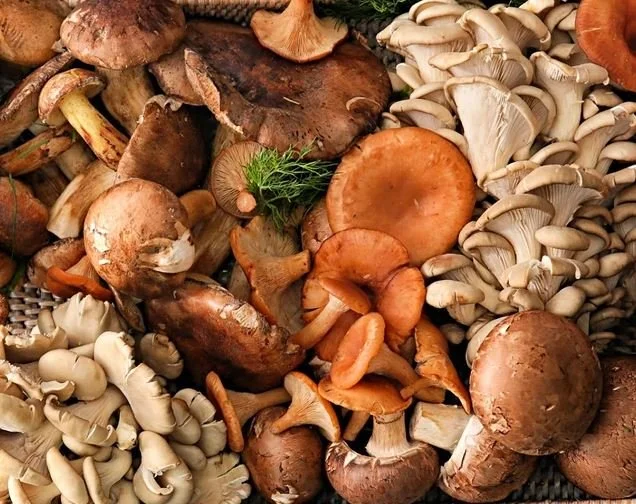Mushroom Season
“Hey, do you want any chickens?” asked a fellow vendor and an ardent fungi forager. I knew he was talking about the kind that grew on dead logs and not the kind with feathers. When I declined due to my own abundance I clarified that I was indeed referring to the brilliant orange and yellow polypores appearing with the arrival of cool, damp weather.
While the first chilly rains of autumn are depressing for some, forest foragers, chefs, and gourmands delight in the abundance of edible mushrooms.
We’ve become accustomed to the commercialization of mushroom growing as their cultivation has grown in popularity over the last twenty years. When I was growing up the only edible mushrooms available were the common white button mushroom, Agaricus bisporus . Occasionally my parents would stop on the way home from the shore to purchase the larger brown criminis or the more mature open capped version referred to as portabello, also A. bisporus. We would stuff them with Blue Crab meat picked from our day of crabbing while on vacation.
But today we have an assortment of varieties—both cultivated and foraged—from which to choose.
Shiitakes (Lentinula edodes) are the standard gourmet mushroom most people think of. They are native to East Asia and have been cultivated for over 6,000 years. Used often in Asian cooking, Shiitakes have a potent umami-rich flavor. It is the cap portion of the fruiting body that is eaten, but don’t toss out those tough stems. They make great broth.
Oyster mushrooms offer a variety of colors and flavors. They come in whites, grays, blues, pinks, and yellows each with a distinctive shape and are all members of Pleurotus ostreatus. This species grow in clusters and have become popular with hobbiest as they are easy to cultivate.
The King Trumpets are also members of the Pleurotus family, but appear quite different in shape and size. Identifed by their long, thick, smooth meaty stems and stout brown caps, they don’t cluster but grow individually. Raw king trumpets have little flavor, but become savory, meaty, and chewy, absorbing the flavors of the ingredients in which they are cooked.
Porcini means "piglets" in Italian and are the most beloved mushroom in Italian cuisine. They have long meaty white stems and reddish-brown caps that are slightly sticky to touch. They are quite large mushrooms with an incredibly robust nutty flavor and intense aroma.
One of my favorites are Porcinis. They are the classic mushroom for Mediterranean cooking with their flavor complimenting pancetta, anchovies, and garlic. Toss them with pasta, blend them into a risotto, nestle them with gnocchi—whatever you do, they have the power to turn a good meal into a great meal. Whatever you do, make sure you cook them as they are indigestible when raw, causing intestinal distress.
One of the best first dates I ever had was going Chanterelle hunting. I’d never foraged for Cantharellus cibarius and the delight of finding the golden nuggets nestle among the damp brown leaves was an afternoon that will stick with me the rest of my life. Little did I realize at the time the importance of someone sharing their spot with me as foragers tend to be guarded when it comes to revealing their hunting grounds. Athough that relationship has long passed, the memory of those Chanterelles lives on when I spy them at market.
When soup season arrives, I reach for the Beech mushrooms. They are my go-to ingredient for everything from simple broths to hearty stews. Also native to Asia they are widely cultivated. Lyophyllum shimeji come in white and brown varieties, both sweet and nutty when cooked. The are typically sold in a solid cluster so if you drop your market bag they won’t go rolling all over the parking lot.
Not to be confused with Chicken of the Woods, Hen of the Woods, AKA: Maitake is a cluster of ruffled fan-shaped caps attached to a thick stem. In addition to being flavorful, Grifola frondosa is also known for its health benefits and is widely used in supplements and traditional medicine. Maitake is rich in Vitamin D, known to reduce blood pressure, lower cholesterol, and boost immunity.
Another favorite for me are the Wood Ears which are ulike most of the fungi you’ll see. These brown, rubbery blobs pop and spit when cooked in a cast iron skillet and hold up to low and slow all day in a crock pot, but they are another fungi not to be consumed raw. Auricularia auricula-judae are gaining in popularity due to their rich pre-biotics, beta glucans. These are indigestible fibres that promote the growth of good bacteria (probiotics) in our microbiome.
These are a handful of fungi that show up at the market, but are by no means the only ones. There are over 10,000 varieties of edible mushrooms worldwide. Fungi are fast becoming the rockstars of the environment along with mycologists such as Paul Stamets and Merlin Sheldrake. While mushrooms have long been popular meat substitutes, they are showing up in new and innovative uses such as textiles, and for replacing unsustainable building materials, plastics and synthetics.
Humans have been harnessing the power and magic of mushrooms for millenia, though. They’ve been worshiped for their hallucinogenic properties and covetted for their colors. All those brilliantly colored tapestries from the Renaissance? Many of those dyes were made with mushrooms. Hopefully humans will get with the program and continue to use mushrooms for more than just a great meal.

